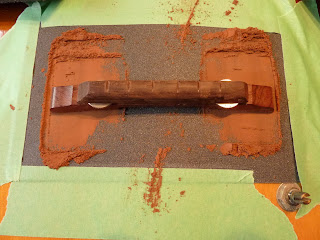A great old maple body archtop in pristine condition ~ this was in for a fret dress and bridge adjustment.
The only thing missing is the tortoise-shell pickguard that covered the wire from the DeArmond pickup to the controls ~ complete with original Bakelite knobs!
The owner had removed the adjustment wheel on the bass side to improve the action. You can also see some space between the bottom of the bridge and top of the soundboard, meaning it isn't shaped perfectly to the contour of the arch. The more positive contact you have, the more sound is transferred through the instrument from the string vibration.
This being an unfixed bridge, the first step is to set the intonation perfectly and mark it just underneath at both ends. You can see here that it sits on a slight angle compared to the photo at the top. Fortunately there is lots of wood to sculpt along the saddle, so perfect intonation was achieved.
Taping some sandpaper to the soundboard where the bridge sits is a great way to form the bottom to the shape of the arch. It's important to let the sandpaper do the work and not push down too hard, as that may cause the piece to rock back & forth creating a rounded bottom. After a few minutes of careful sanding while holding it at the angle of intonation, you can see that only the outside edges of the bridge were in contact.
A few minutes later the whole bottom surface was in contact. I then taped over the trebble side and brought the bass side down some more to improve the action while making it adjustable again.
Problem solved ~ positive contact with perfect intonation and action!
The inlays on this guitar aren't inlays at all ~ they're painted on! They were taped over for the fret dress. After a fretboard cleaning and lubricating the original exposed-gear tuners, this guitar was given a thorough polish and was ready for the next 50 years of music!







